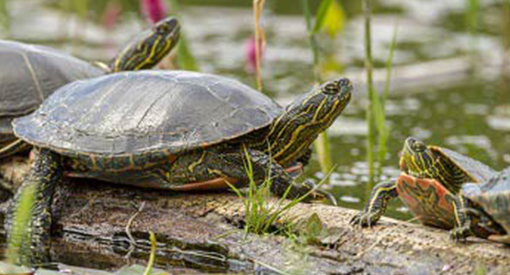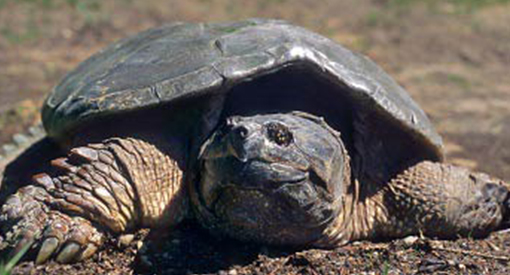
Herpetofauna
Chambly Canal National Historic Site
Herpetofauna combines amphibians and reptiles. According to the Red List by the International Union for Conservation of Nature, this category of animals has the highest percentage of at-risk species: among them, 41% of amphibians and 21% of reptiles are threatened with extinction.
Amphibians and reptiles live in wetlands, and aquatic and terrestrial environments to reproduce, feed and hibernate. In order to increase its knowledge about their presence at the Chambly Canal National Historic Site and properly plan rehabilitation work, Parks Canada conducted wildlife inventories of these species in targeted areas along the canal, like Fryer Island.
Species observed
Turtles


What are the species of turtles found near the Chambly Canal?
Snapping turtles, painted turtles, spiny softshell turtles and map turtles have been reported at or near the Canal.
When can I observe turtles at the Chambly canal?
In spring and summer, when sunning themselves on floating logs to warm up.
When the turtles lay their eggs?
In early June; turtles can also be seen digging nests in granular or sandy materials to lay their eggs.
Did you know?
A turtle uses all its vital energy to dig its nest; it is therefore very important not to approach or disturb turtles during that time since it could cause them to flee and lose their eggs.
In addition, turtles are dedicated to the nesting site that they carefully chose for very specific temperature and humidity reasons. They prefer sunny, open areas and near water. They tend to return there every year to nest, unless the habitat has changed.
Unfortunately, with snapping turtles, the babies’ survival rate is low. Less than 23% survive and up to 94% of the nests are raided by raccoons, red foxes and other predators near urban areas like skunks, opossums and coyotes. With painted turtles, the survival rate is up to 30% and 70 to 100% of nests are raided by predators, generally within 48 hours after laying the eggs.
That is the reason why it can be helpful to signal a nest or a turtle laying its eggs to take action promptly and protect the nest with a screened-in shelter until the babies are born.
Snapping turtles can lay between 25 and 45 eggs, which hatch between August and October. When they are born, babies get to the nearest body of water to bury themselves under the debris for the winter. As for painted turtles, females will lay up to a dozen eggs. Once they get out of their shell, young painted turtles can survive winter in their nest because they tolerate low temperatures (-10 ºC) and oxygen-poor environments during their first year of life.
Anurans

What are the species of anurans found at the Chambly Canal?
The green frog, the wood frog, the northern leopard frog, the American toad and the bullfrog live at the Chambly Canal site.
When can I observe and hear anurans at the Chambly canal?
As soon as the snow melts, especially in the Fryer Island area. It is possible to hear their singing during mating period according to the specie, that can start at the end of March for the wood frog and up until June for the green frog and the bullfrog.
Did you know?
These species are very useful to humans because they limit the number of insect pests, and their secretions are useful and highly studied in the field of medicine for developing vaccines.
Snakes

What are the species of snakes found at the Chambly Canal?
Only garter snakes are found along the canal.
Why snakes are useful for the ecosystem?
Quebec’s snakes are completely harmless and don’t have fangs. They are very useful for an ecosystem’s balance because they are both prey and predator, as well as exterminators of rodents that are sometimes harmful or overpopulated.
When can I observe snakes at the Chambly canal?
They prefer places where there is an abundance of shelter, such as planks, flat rocks and logs on the ground for hiding in. They need to warm themselves in the sun or under heat-absorbing items, like asphalt shingles or pieces of sheet metal. They can even lay their eggs there. Otherwise, they prefer to lay their eggs in stumps, mammal burrows, piles of leaves, under debris on the ground, or right in the ground if it’s loose.
Did you know?
The females stop eating for a few weeks before laying to conserve their energy for egg development rather than for searching for food.
Related links
- Date modified :